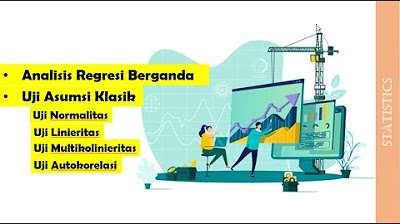Part 18: Multiple Correlation of Coefficient | "r" and "R" Calculation | Biostatistics & RM
Summary
TLDRIn this video, the concept of multiple correlation analysis is discussed, focusing on the relationship between multiple variables. It explains how independent and dependent variables interact in a multiple correlation scenario. The video goes into the specifics of calculating correlation coefficients, providing examples and formulas to help viewers understand how to measure the relationship between more than two variables. Through step-by-step guidance, the viewer is shown how to compute values using the multiple correlation formula and apply it in real-world examples.
Takeaways
- 😀 **Multiple correlation** analyzes the relationship between one independent variable and multiple dependent variables.
- 😀 In **multiple correlation**, the independent variable can influence two or more dependent variables simultaneously.
- 😀 The formula for calculating the **multiple correlation coefficient** involves the observed and predicted values of the dependent variables.
- 😀 **Independent variables** are those manipulated or changed, while **dependent variables** depend on these changes.
- 😀 The multiple correlation coefficient, denoted as **R**, quantifies how well the independent variable predicts the dependent variables.
- 😀 To calculate multiple correlation, you need to compute pairwise correlations between the independent and dependent variables.
- 😀 The formula for multiple correlation requires computing squared differences of observed and predicted values and finding the total sum.
- 😀 The final **R value** indicates the strength of the relationship: the closer it is to 1, the stronger the relationship.
- 😀 The script includes practical steps for calculating multiple correlation manually, though statistical software like Excel is often used for such tasks.
- 😀 For three variables (e.g., **A**, **B**, and **C**), you calculate correlations between each pair and then use a specific formula to find the overall multiple correlation.
- 😀 Multiple correlation helps in understanding how different factors (e.g., time spent studying, intelligence) impact a particular outcome, by analyzing various relationships together.
Q & A
What is the main topic of the video?
-The main topic of the video is multiple correlation, which explores the relationship between one dependent variable and multiple independent variables in statistics.
How does multiple correlation differ from simple correlation?
-Multiple correlation involves the relationship between one dependent variable and more than one independent variable, while simple correlation only examines the relationship between two variables.
What are the types of variables discussed in the video?
-The video discusses two types of variables: independent variables (predictors) and dependent variables (the ones being predicted or explained).
What is an independent variable in the context of multiple correlation?
-An independent variable is a variable that is used to predict the dependent variable. It is not affected by other variables in the analysis.
What formula is used to calculate the multiple correlation coefficient?
-The multiple correlation coefficient is calculated using a formula that involves the correlation coefficients between the dependent variable and each independent variable. The video explains how to compute this through summation (Σ) and square root operations.
What role does the summation notation (Σ) play in calculating correlation?
-The summation notation (Σ) is used to aggregate data points, such as summing up squared values or differences in data, which is an essential step in calculating the correlation coefficient.
What is the significance of the correlation coefficient value?
-The correlation coefficient indicates the strength and direction of the relationship between variables. A value closer to 1 suggests a strong positive correlation, while a value closer to -1 suggests a strong negative correlation.
How can one interpret the result of a multiple correlation calculation?
-The result of a multiple correlation calculation provides a value that reflects how well the independent variables together predict or explain the dependent variable. A higher value indicates a stronger predictive relationship.
What is the role of dependent variables in multiple correlation analysis?
-The dependent variable is the one being predicted or explained. In multiple correlation, it is influenced by the multiple independent variables, and the goal is to understand how changes in the independent variables affect the dependent variable.
Can the video example be used to calculate the multiple correlation in real-life data?
-Yes, the example provided in the video demonstrates the step-by-step calculation of multiple correlation. This method can be applied to real-life data where multiple independent variables are being used to predict a dependent variable.
Outlines

This section is available to paid users only. Please upgrade to access this part.
Upgrade NowMindmap

This section is available to paid users only. Please upgrade to access this part.
Upgrade NowKeywords

This section is available to paid users only. Please upgrade to access this part.
Upgrade NowHighlights

This section is available to paid users only. Please upgrade to access this part.
Upgrade NowTranscripts

This section is available to paid users only. Please upgrade to access this part.
Upgrade NowBrowse More Related Video

TUTORIAL SPSS : Multiple Correlation Test SPSS

Pearson Correlation Analysis using SPSS - Running, Interpreting, and Reporting

Correlation Analysis

Cara Mudah Mencari Uji Koefisien Korelasi Sederhana Dan Berganda

(1/4) Analisis Regresi : Uji asumsi Klasik

Analisis Korelasi - Matematika Wajib SMA Kelas XI Kurikulum Merdeka
5.0 / 5 (0 votes)